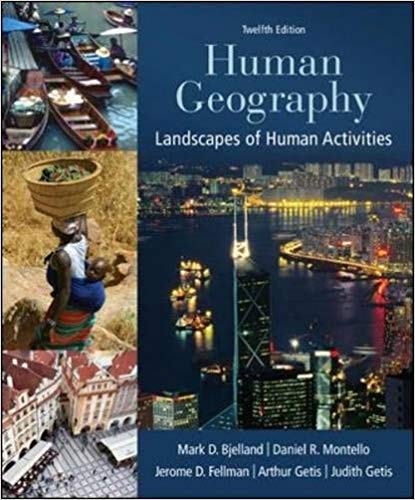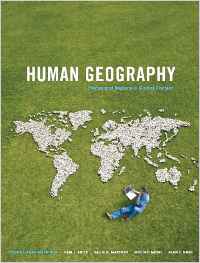Description
Test Bank Human Geography Landscapes of Human Activities 12th edition
Chapter 1 Introduction – Some Background Basics
Student: _________________________________________________________
1. Every map projection has some degree of distortion because
A. a curved surface cannot be represented on a flat surface without distortion.
B. parallels and meridians never cross at right angles on a globe.
C. the grid of latitude and longitude cannot be accurately measured.
D. a sphere is a developable surface.
2. All regions have the following characteristics EXCEPT
A. relative location.
B. derived location.
C. spatial extent.
D. boundaries.
3. A street address is an example of
A. relative position.
B. prime position.
C. absolute location.
D. situation.
4. Which of the following statements about latitude is NOT true?
A. Latitude is a measure of distance north and south of the equator.
B. Latitude lines are always parallel to each other.
C. Latitude is always written as some number between 0 degrees and 180 degrees.
D. On a globe, lines of latitude intersect meridians of longitude at right angles.
5. Which of the following is NOT a type of quantitative thematic map?
A. isometric map
B. choropleth map
C. topographic map
D. cartogram
6. The location of a place described by its local physical characteristics is called its
A. relative position.
B. site.
C. normative locale.
D. situation.
7. A contour is an isoline showing
A. points of equal elevation.
B. points equidistant from a known, central location.
C. average value of an item studied per unit area of its occurrence.
D. the degree of small area distortion on thematic maps.
8. Which of the following is NOT true about the globe grid?
A. All meridians are one-half the length of the equator.
B. Meridians and parallels intersect at right angles.
C. Parallels increase in length as one nears the poles.
D. The scale on the surface of the globe is the same in every direction.
9. Which of the following is NOT a characteristic of regions?
A. hierarchical arrangement
B. spatial extent
C. historical sequence
D. defined boundaries
10. Density and dispersion are independent statements about the location of things within a defined area. They are different in that
A. density is the number of items in the area and dispersion describes their proximity.
B. dispersion reports the mobility or changeability of items in an area and density reports their degree of permanence.
C. density is a perceived relationship of things in space and dispersion is the mathematical relationship of spatial data.
D. dispersion is a spatial statement valid for functional regions and density has meaning only for formal regions.
11. The elements common to all spatial distributions are
A. site, situation, and localization.
B. accessibility, connectivity, and pattern.
C. concentration, dissonance, and connectivity.
D. density, dispersion, and pattern.
12. Perceptual regions
A. reflect personal or popular impressions of territory and spatial divisions.
B. are perceived through the application of well-defined spatial criteria.
C. have boundaries of clearly visible, self-evident physical or cultural change.
D. have meaning only in physical geography, which deals with perceivable objects.
13. An isoline on a map
A. measures the concentration of the mapped item.
B. measures dispersion of the mapped item.
C. connects points of equal value to the mapped item.
D. outlines the area of the map with no globe grid distortion.
14. Which one of the following correctly lists the four main properties of maps?
A. area, direction, latitude, longitude
B. equivalence, shape, latitude, longitude
C. conformality, equivalence, direction, symbols
D. area, shape, distance, direction
15. All of the following are key reference points in the grid system EXCEPT the
A. North and South Poles.
B. polar circumference.
C. equator.
D. prime meridian



Be the first to review “Test Bank Human Geography Landscapes of Human Activities 12th edition”